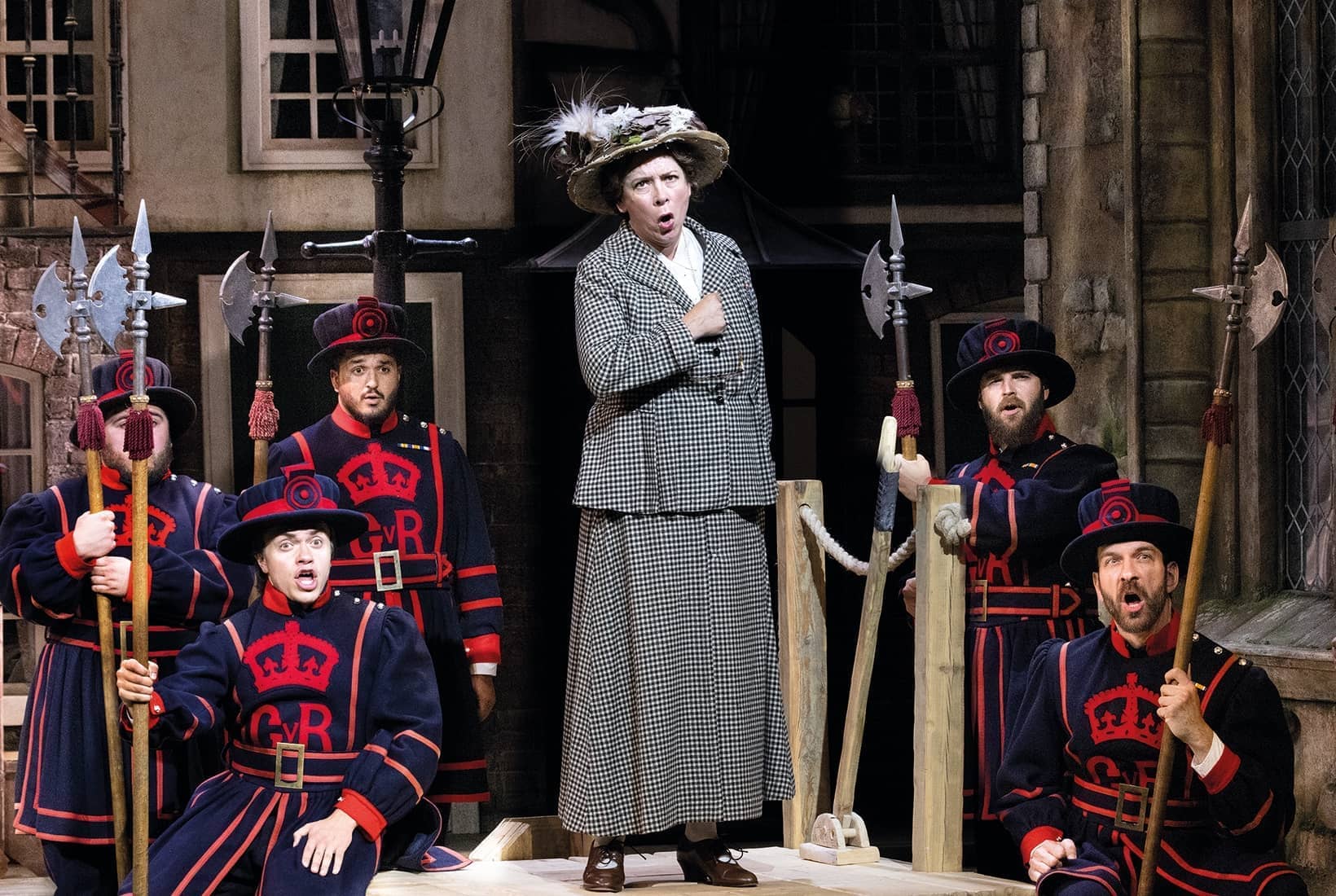The Yeomen of the Guard has been called the ‘English Meistersinger’ but the more you think about that, the dafter it gets.
It’s not just the very obvious difference in scale and means between Wagner’s five-hour national epic and Gilbert and Sullivan’s sprightly opéra comique. Wagner’s whole drama builds to a collective affirmation of German art. The Yeomen begins by setting up a fantasy of an English golden age – the Tower of London in the 16th century – then systematically cuts it to ribbons.
Act One’s gallant hero becomes Act Two’s callous seducer, whose march towards his own happy ending leaves a trail of collateral damage: a spiral of lies, two all-but-forced marriages and the unheeded emotional destruction of at least one central character. European directors work overtime (and how!) to puncture the uplift at the end of Die Meistersinger. If the director of The Yeomen merely follows Gilbert’s instructions to the letter, audiences gasp out loud with dismay.
The chorus emerged like human cuckoos from half-timbered clocks. Time to sing? Out they pop
In short, I had high hopes for Christopher Luscombe’s new production at the Grange Festival; unreasonably high, perhaps. The cast and company are excellent: Ellie Laugharne as Elsie, Graeme Broadbent as Sergeant Meryll and John Savournin as Sir Richard Cholmondeley (in G&S terms, not so much luxury casting as platinum-plated), all under the baton of John Andrews, a conductor who absolutely understands Sullivan’s style – which is to say, he conducts it with the transparent, lyrical verve of early Mendelssohn.
A less familiar name is Nick Haverson as the jester Jack Point, whose vocal dexterity (he’s what you might call a character baritone, but he gets around Gilbert’s tongue-twisting patter as nimbly as Fred Astaire) was matched by an astonishing physical agility – pratfalling, capering and cringing with a supple, controlled energy that was like watching the music itself take physical form.
In Luscombe’s conception – and this was an inspired notion in a production that wasn’t big on ideas – Point is an ageing music-hall comedian: a weary but game old pro who can see the final curtain and is banking on a retirement tended by the much younger Elsie. The setting is still the Tower, but it’s been updated for no obvious reason to the first world war (we’ve seen Wolf Hall – does Tudor still have to mean twee?), with Colonel Fairfax’s imminent beheading being translated (for reasons which do ultimately become clear) into hanging.
The set is another brightly lit Grange Festival spectacular: lavishly realistic without looking remotely real, like some studio-bound 1970s BBC period drama. Judging from comments overheard in the interval, this was a big hit – the D’Oyly Carte company was mentioned (in fact, the original D’Oyly Carte switched to minimalist semi-abstract sets for Yeomen as far back as 1940). The general air of a Blue Peter Christmas special extended to Luscombe’s handling of the big set pieces: he marched the Yeomen on and marched them off again, while the chorus emerged from their houses like human cuckoos from half-timbered clocks. Time to sing? Out they pop.
That was a pity because there were some nuanced individual performances (a sympathetic jailer Shadbolt from Nicholas Crawley, Laugharne’s luminous, conflicted Elsie and Angela Simkin as Phoebe Meryll, whose singing was sweet and whose face was a picture as she watched her dreams unravel). Nick Pritchard sang with eloquent charm as a smooth-cheeked public-school Fairfax; the orchestra sparkled and glowed. And of course there was the ongoing disintegration of Haverson’s Jack Point; which amid all the marching and rhubarbing never quite felt like it was given the space it needed.
Sunny escapism is a necessary element of Gilbert and Sullivan’s appeal, and it gets its due here. But if you long to feel more of the melancholy behind the mock-Tudor façade of this most Shakespearean of English comic operas, you’ll continue to wait (more in hope than expectation) for ENO’s forthcoming production in November.
Jack Furness’s new staging of Dvorak’s Rusalka at Garsington makes light and shade its playthings: throwing rich shadows through a towering, steampunky steel forest, holding the moonstruck heroine spellbound in a pure white beam, and striking glinting, shimmering reflections from the circular pool of water that dominates the set.
It looks breathtaking (Malcolm Rippeth is the lighting designer) and the musical and dramatic performances find a complexity, a depth and a red-blooded emotional truth that I hadn’t thought possible in this lovely but sometimes chilly fairy-tale opera.
Douglas Boyd draws sounds of Siegfried-like enchantment from the Philharmonia Orchestra, Gerard Schneider sings with Italianate lyricism as the Prince and, as Rusalka, Natalya Romaniw just gets better and better and better: vulnerable, passionate and with a voice that arcs through the darkness like the tail of a comet. This is as good as opera gets, on a par with anything you’d experience in a major international house. See it if you can.







Comments